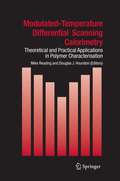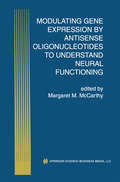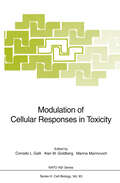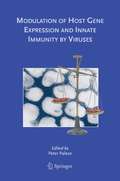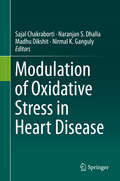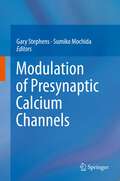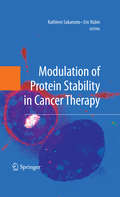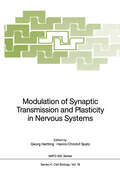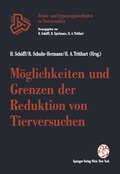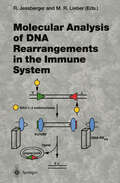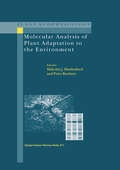- Table View
- List View
Modulare Revisionsendoprothetik des Hüftgelenks
by Peter Thümler Raimund Forst Günther ZeilerIn dem vorliegenden Buch mit dem Titel Modulare Revisionsendoprothetik des Hüftgelenks stellen sich die drei namhaften Herausgeber und viele weltweit anerkannte Experten diesem Thema. Sie verraten dabei Tricks und beschreiben ihre langjährigen Erfahrungen bei Wechseloperationen in der Hüftendoprothetik mit modularen Implantaten. Revisionskonzepte, Grundlagen und Biomechanik modularer Revisionsimplantate, sowie Indikationen und operative Techniken und die anschließende Rehabilitation werden darin ausführlich beschrieben. Erstmalig in einem Buch erfolgt eine Übersicht von klinischen Ergebnissen von modularen Schaftimplantaten unterschiedlicher Prothesenhersteller. Alles in allem ein Buch, das dem Operateur bei den häufig schwierigen Revisions-eingriffen im Bereich des Hüftgelenkes und bei der Wahl des zu verwendenden Implantates wertvolle Anregungen gibt.
The Modulated Scream: Pain in Late Medieval Culture
by Esther CohenIn the late medieval era, pain could be a symbol of holiness, disease, sin, or truth. It could be encouragement to lead a moral life, a punishment for wrong doing, or a method of healing. Exploring the varied depictions and descriptions of pain—from martyrdom narratives to practices of torture and surgery—The Modulated Scream attempts to decode this culture of suffering in the Middle Ages. Esther Cohen brings to life the cacophony of howls emerging from the written record of physicians, torturers, theologians, and mystics. In considering how people understood suffering, explained it, and meted it out, Cohen discovers that pain was imbued with multiple meanings. While interpreting pain was the province only of the rarified elite, harnessing pain for religious, moral, legal, and social purposes was a practice that pervaded all classes of Medieval life. In the overlap of these contradicting attitudes about what pain was for—how it was to be understood and who should use it—Cohen reveals the distinct and often conflicting cultural traditions and practices of late medieval Europeans. Ambitious and wide-ranging, The Modulated Scream is intellectual history at its most acute.
The Modulated Scream: Pain in Late Medieval Culture
by Esther CohenIn the late medieval era, pain could be a symbol of holiness, disease, sin, or truth. It could be encouragement to lead a moral life, a punishment for wrong doing, or a method of healing. Exploring the varied depictions and descriptions of pain—from martyrdom narratives to practices of torture and surgery—The Modulated Scream attempts to decode this culture of suffering in the Middle Ages. Esther Cohen brings to life the cacophony of howls emerging from the written record of physicians, torturers, theologians, and mystics. In considering how people understood suffering, explained it, and meted it out, Cohen discovers that pain was imbued with multiple meanings. While interpreting pain was the province only of the rarified elite, harnessing pain for religious, moral, legal, and social purposes was a practice that pervaded all classes of Medieval life. In the overlap of these contradicting attitudes about what pain was for—how it was to be understood and who should use it—Cohen reveals the distinct and often conflicting cultural traditions and practices of late medieval Europeans. Ambitious and wide-ranging, The Modulated Scream is intellectual history at its most acute.
Modulated Temperature Differential Scanning Calorimetry: Theoretical and Practical Applications in Polymer Characterisation (Hot Topics in Thermal Analysis and Calorimetry #6)
by Mike Reading Douglas J. HourstonMTDSC provides a step-change increase in the power of calorimetry to characterize virtually all polymer systems including curing systems, blends and semicrystalline polymers. It enables hidden transitions to be revealed, miscibility to be accurately assessed, and phases and interfaces in complex blends to be quantified. It also enables crystallinity in complex systems to be measured and provides new insights into melting behaviour. All of this is achieved by a simple modification of conventional DSC. In 1992 a new calorimetric technique was introduced that superimposed a small modulation on top of the conventional linear temperature program typically used in differential scanning calorimetry. This was combined with a method of data analysis that enabled the sample’s response to the linear component of the temperature program to be separated from its response to the periodic component. In this way, for the first time, a signal equivalent to that of conventional DSC was obtained simultaneously with a measure of the sample’s heat capacity from the modulation. The new information this provided sparked a revolution in scanning calorimetry by enabling new insights to be gained into almost all aspects of polymer characteristics. This book provides both a basic and advanced treatment of the theory of the technique followed by a detailed exposition of its application to reacting systems, blends and semicrystalline polymers by the leaders in all of these fields. It is an essential text for anybody interested in calorimetry or polymer characterization, especially if they have found that conventional DSC cannot help them with their problems.
Modulating Gene Expression by Antisense Oligonucleotides to Understand Neural Functioning (Perspectives in Antisense Science #1)
by Margaret M. McCarthyWhen first introduced, antisense oligonucleotides were hailed as the long awaited magic bullet that would provide an unprecedented level of specificity in controlling gene expression. Following this initial enthusiasm, antisense oligonucleotides have been maligned as nonspecific, toxic, and essentially useless. However, application of antisense oligonucleotide technology in the nervous system stands apart from the use of this technique in peripheral systems, largely because of its enormous success. The source of this success remains a matter of some controversy. Modulating Gene Expression by Antisense Oligonucleotides to Understand Neural Functioning addresses the origins of that controversy and determines whether the nervous system is a privileged site for antisense oligonucleotide action and not subject to the same vagaries and pitfalls as non-neuronal systems. Modulating Gene Expression by Antisense Oligonucleotides to Understand Neural Functioning contains chapters by experts in the field that focus on the use of this technique in a variety of behavioral systems, as well as rapid and nonspecific effects and the uptake and metabolism of antisense oligonucleotides by the nervous system. Modulating Gene Expression by Antisense Oligonucleotides to Understand Neural Functioning features: experts in the field reporting on the use of antisense oligonucleotide technology in a variety of behavioral systems, including pain control, circadian rhythms, ingestion and control of water balance, and reproductive behaviors; the novel use of plasmids to express antisense RNA in the nervous system; the biodistribution and metabolism of antisense oligonucleotides in the nervous system; rapid and unusual effects; and non-specific effects.
Modulation of Cellular Responses in Toxicity (Nato ASI Subseries H: #93)
by Corrado L. Galli Marina Marinovich Alan M. GoldbergProceedings of the NATO Advanced Study Institute on the Modulation of Cellular Response in Toxicity, held in Ponte di Legno, Italy , January 24 - February 3, 1994.
Modulation of Host Gene Expression and Innate Immunity by Viruses
by Peter Palese Jean-Pierre ChangeuxThis book is an excellent, up-to-date reference on a relatively young area of research in which virology, cellular biology and molecular pathogenesis govern the principles of coinvestigation. Thus, the book will be of great interest to virologists, molecular immunologists and biologists, and biochemists but also to clinical pharmacologists in the long-term search for new antiviral agents. Ulrich Desselberger, Gif-sur-Yvette/Cambridge. Infection of a naïve (non-immune) host with a virus elicits an immediate response which results in a cascade of changes in the host, including an interferon response (innate immunity). The outcome of this interaction is influenced by the genes of the virus as well as the genes of the host. Interestingly, different viruses do it in different ways. Not only is there a plethora of mechanisms used by the invading organisms, but the host has also evolved a great variety of redundant and robust countermeasures. This interplay of host and virus represents one of the most significant frontiers in biology today. A clearer understanding of the mechanisms involved will arm us with better strategies to deal with viruses, including emerging pathogens and potential bioterrorism agents. This book is sure to benefit students, scientists, and physicians working in the areas of virology, immunology, microbiology, and infectious diseases. Pharmaceutical industry professionals will also find interest in this illuminating look into virus/host interactions.
Modulation of Oxidative Stress in Heart Disease
by Naranjan S. Dhalla Nirmal K. Ganguly Sajal Chakraborti Madhu DikshitThis book highlights the multifaceted roles of Reactive Oxygen Species (ROS) in modulating normal cellular and molecular mechanisms during the development of different types of heart disease. Each chapter in the book deals with the role that altered redox homeostasis plays in the pathophysiology of heart disease. In addition, the book explains how reactive oxidant species interact with their targets and provides novel strategies for attenuating oxidative stress-induced types of heart disease.The book not only covers ROS-induced response in heart disease at the cellular level, but also demonstrates that an imbalance of redox states has its roots in our genes, and explains the ways gene expression is regulated. In turn, it reviews potential sources of ROS, their pathological effects on the heart, and potential sites for therapeutic interventions.
Modulation of Presynaptic Calcium Channels
by Gary Stephens and Sumiko MochidaThis book will bring together leading international experts to discuss recent advances in basic scientific knowledge regarding the regulation of presynaptic Ca2+ channels. Importantly, Ca2+ channels represent one of the most widely modulated proteins in the body, being the target of a range of effector pathways and drugs; this range will be fully represented here. A number of therapeutic drugs target the Ca2+ channel complex, including the anti-epileptic gabapentinoid and analgesic ziconotide drugs and the pharmaceutical industry is searching for Ca2+ channel blocking drugs, particularly in the pain, epilepsy, ataxia and migraine areas. Such potential future therapies will be discussed here. Scientific disciplines will focus on electrophysiological studies, but will extend to neuroscience, genetics and biochemical areas. The work described will represent advances at the cutting edge of current neuroscience research and is timely and highly appropriate for the Springer book series.
Modulation of Protein Stability in Cancer Therapy
by Eric Rubin Kathleen SakamotoThis comprehensive monograph on the role of protein modulation in cancer therapeutics focuses on targeting molecules that regulate protein stability in a variety of tumors. Topics covered include ubiquitin ligases, deubiquitinating enzymes, and the proteasome.
Modulation of Synaptic Transmission and Plasticity in Nervous Systems (Nato ASI Subseries H: #19)
by Georg Hertting Hanns-Christof SpatzThis volume is based on a workshop "Modulation of Synaptic Transmission and Plasticity in Nervous Systems" held in n Ciocco, Castelvecchio, Pascoli, Italy, from September 8th to 13th, 1987. The purpose of the meeting was to bring together scientists working on plasticity in nervous systems on different levels. The contributions can be subgrouped into six fields of research: 1) Presynaptic Modulation of Chemical Neurotransmission 2) Postsynaptic Signal Transduction 3) Modulation of Synaptic Transmission and Plasticity in the Hippocampus 4) Modulation of Neuromuscular Transmission 5) Molecular and Cellular Analysis of Conditioning in Marine Snails 6) Analysis of Learning and Memory in Insects Understanding how nervous systems and in particular our brain processes and stores information has been a major challenge in science for centuries and will remain for some time to come. Not until recently neurobiologists agreed to seek plasticity of behavior primarily in the modulation of the properties of synapses between nerve cells. This is to be understood within the context provided by a neural circuitry. An important stimulus came from the work on the marine snail Aplysia, where learning processes can be described as a modulation of transmitter release, traced back to a complete chain of molecular events in an identified neuron. Learning became a topic of molecular biology. Three systems appear particularly promising for this approach: insects, in particular Drosophila, marine snails and the mammalian hippocampal tissue. Our views on neurotransmission have rapidly changed.
Modulators, Mediators, and Specifiers in Brain Function: Interactions of Neuropeptides, Cyclic Nucleotides, and Phosphoproteins in Mechanisms Underlying Neuronal Activity, Behavior, and Neuropsychiatric Disorders (Advances in Experimental Medicine and Biology #116)
by Y. H. ErlichWhile neuroanatomy and neurophysiology were defining the unique features of the synapse as a site for cell to cell signaling in the late fifties, neurochemistry was establishing the identity and studying the biosynthetic pathways of monoamine neurotransmitters. Meanwhile, neuropsychiatry was keeping a vigilant eye on the outcome of this concerted effort with the untold hope that a genetic defect in neurotransmitter metabolism would ac count for the pathogenesis of certain psychiatric ill nesses. Thus, when neurochemists in the early sixties began to study the feasibility of measuring the metabolism of brain neurotransmitters in vivo, clinical biochemists eagerly adopted these methods to their needs and sought to verify whether inborn errors of transmitter biogenesis were a cause for at least certain forms of depression, mania and schizophrenia. Undoubtedly, it is still too early to evaluate the outcome of these studies. However, current opinion holds that gross inborn errors in transmitter metabolism do not anpear to be operative as a primary cause of psychia tric disorders. Though monoamine metabolism appears to be defective in certain groups of psychiatric disorders, the cause of these changes can at best be associated with changes in patterns of neuronal firing. It is generally believed that these persistent changes are determined by a number of unknown factors operative in various psychia tric illnesses. In the attempt to identify the molecular nature of these unknown factors, the focus of current research is directed toward transmitter receptors.
Möglichkeiten und Grenzen der antineoplastischen Therapie: Band 1: Bronchialkarzinom, Mammakarzinom
by K. W. Brunner F. Cavalli H. P. Heilmann D. K. Hossfeld T. Junginger H. O. Klein H. B. Makoski N. Niederle H. Pichlmayer R. Sauer S. SeeberMöglichkeiten und Grenzen der Medizin
by Christian Herfarth Heinz-Johannes BuhrMöglichkeiten und Grenzen der Medizin werden hinsichtlich des wirklich möglichen medizinischen Fortschritts und des wirtschaftlich Machbaren in Frage gestellt. Es muß in der Medizin umgedacht werden: Trennung von Forschung und Lehre ist nur eine Frage. Aufteilung und Reduzierung der klinischen Arbeit charakterisieren eine andere Stoßrichtung. Versicherungsrechtliche Berechnungen, versicherungspolitische Ansichten und der demographische zukünftige Altersaufbau können zu Zwängen führen, die den ethischen und individuellen Rechtsanspruch eines Kranken auf beste Behandlung gefährden. Hervorzuheben ist die interdisziplinäre Auseinandersetzung aus der Sicht des Theologen, Juristen, Wirtschaftswissenschaftlers und Klinikers.
Möglichkeiten und Grenzen der Reduktion von Tierversuchen (Ersatz- und Ergänzungsmethoden zu Tierversuchen)
by Harald Schöffl Rolf Schulte-Hermann Helmut A. TritthartDer erste Band der neuen Reihe gibt einen weitgefächerten Überblick über die Probleme, Grenzen und Möglichkeiten, Tierversuche in der biomedizinischen Forschung zu reduzieren. Behandelt werden die gesetzlichen Grundlagen in den deutschsprachigen Ländern, Toxikologie und In-Vitro-Toxikologie, In-Vitro-Systeme in Pharmakologie und Physiologie, Immunologie, Molecular Modelling, Videomikroskopie, In-Vitro-Systeme in der Krebsforschung und in der Ökotoxikologie. Experten aus Industrie, Universität und Behörden versuchen, bisher Geleistetes darzustellen, Schwachstellen aufzuzeigen und zukunftsträchtige Problemlösungsmodelle vorzustellen.
Möglichkeiten zur Optimierung der Parkinson-Therapie: Proceedings vom 9th Int. Symposium on Parkinson’s Disease, 5.–9. Juni 1988 in Jerusalem
by Till KeilMohs and Cutaneous Surgery: Maximizing Aesthetic Outcomes
by Alexander BerlinAchieving the best aesthetic results in Mohs and other cutaneous surgery requires proper patient selection, careful surgical technique, and meticulous postoperative care. Yet despite the best efforts of both surgeon and patient, complications may develop, sometimes resulting in suboptimal or objectionable scarring.Mohs and Cutaneous Surgery: Maximi
Mohs and Cutaneous Surgery: Maximizing Aesthetic Outcomes
by Alexander BerlinAchieving the best aesthetic results in Mohs and other cutaneous surgery requires proper patient selection, careful surgical technique, and meticulous postoperative care. Yet despite the best efforts of both surgeon and patient, complications may develop, sometimes resulting in suboptimal or objectionable scarring.Mohs and Cutaneous Surgery: Maximi
Mohs Micrographic Surgery
by Keyvan NouriThis book is written for dermatologists, otolaryngologists, facial plastic surgeons and any physician who want to provide state of the art treatment for skin cancer patients. Considering the high incidence of non-melanoma skin cancers such as Basal Cell Carcinoma and Squamous Cell Carcinoma (accounting for over one million cases per year in the United States) and since Mohs Micrographic Surgery has become the treatment of choice for these skin cancers, the popularity of this technique has been increasing dramatically, worldwide.
Molar Incisor Hypomineralization: A Clinical Guide to Diagnosis and Treatment
by Katrin BekesThis book is a wide-ranging reference on current clinical and scientific knowledge regarding the various aspects of molar incisor hypomineralization (MIH). Background information is first presented on the structural properties of hypomineralized enamel, the prevalence of MIH, and potential etiological factors. Subsequent chapters focus on key considerations in clinical practice. Diagnostic criteria, classifications, and treatment strategies are discussed and detailed attention is devoted to potential associations between MIH and caries, the occurrence of hypomineralized primary teeth, and the knowledge and experience of dentists concerning MIH. In the last part of the book, the different treatment options are systematically presented and reviewed, covering pain control, prophylaxis and desensitization, fissure sealing, direct and indirect restorations, and extraction therapy. The cost-effectiveness of the available procedures is also considered. The book is written by acknowledged international experts in the field and will be an ideal source of up-to-date information and guidance for both dental professionals and postgraduate students.
Molecular Allergy Diagnostics: Innovation for a Better Patient Management
by Jörg Kleine-Tebbe Thilo JakobThis book, based on a recent German publication, offers an overview of basic data and recent developments in the groundbreaking field of molecular allergology. It comprehensively explores the origin and structure of single allergen molecules ("components") and their utility in improving the management of type I, IgE-mediated allergic reactions and disorders like allergic respiratory diseases, food allergies, and anaphylaxis. Highly specific testing, called component-resolved diagnostics, aims to identify and utilize single molecules. Over 200 single allergens from plant or animal sources have been applied to single or multiplex laboratory testing for the presence of allergen-specific IgE. This leap in assay sensitivity and specificity has led to three major advances in patient management: discrimination between primary allergic sensitization and complex cross-reactivity, recognition of IgE profiles for certain allergens and identification of patients most likely to benefit from allergen-specific immunotherapy. The book discusses in detail the benefits and limitations of this 21st century technology, and offers suggestions for the use of molecular allergology in routine clinical practice. It is a “must read” for physicians treating allergic patients as well as scientists interested in natural allergic molecules and their interactions with the human immune system.
Molecular Analysis of B Lymphocyte Development and Activation (Current Topics in Microbiology and Immunology #290)
by Harinder Singh Rudolf GrosschedlMolecular Analysis of Cancer (Methods in Molecular Medicine #68)
by Jacqueline Boultwood and Carrie FidlerOver the past 20 years, technological advances in molecular biology have proven invaluable to the understanding of the pathogenesis of human cancer. The application of molecular technology to the study of cancer has not only led to advances in tumor diagnosis, but has also provided markers for the assessment of prognosis and disease progression. The aim of Molecular Ana- sis of Cancer is to provide a comprehensive collection of the most up-to-date techniques for the detection of molecular changes in human cancer. Leading researchers in the field have contributed chapters detailing practical pro- dures for a wide range of state-of-the-art techniques. Molecular Analysis of Cancer includes chapters describing techniques for the identification of chromosomal abnormalities and comprising: fluor- cent in situ hybridization (FISH), spectral karyotyping (SKY), comparative genomic hybridization (CGH), and microsatellite analysis. FISH has a pro- nent role in the molecular analysis of cancer and can be used for the detection of numerical and structural chromosomal abnormalities. The recently described SKY, in which all human metaphase chromosomes are visualized in specific colors, allows for the definition of all chromosomal rearrangements and marker chromosomes in a tumor cell. Protocols for the detection of chromosomal re- rangements by PCR and RT-PCR are described, as well as the technique of DNA fingerprinting, a powerful tool for studying somatic genetic alterations in tumorigenesis.
Molecular Analysis of DNA Rearrangements in the Immune System (Current Topics in Microbiology and Immunology #217)
by Michael R. Lieber RolfJessbergerThe vertebrate immune system is distinctive among defense systems of multicellular organisms. In addition to nonspecific immunity, it generates a randomized array of millions of antigen receptors (immunoglobulins and T-cell receptors). A subset of these receptors are critical for binding to invading microbes or biochemicals from them to tag the microbes for elimination. Three site-directed DNA modification processes are critical to this process in vertebrates. V(D)J recombination generates the array of exons that encode the antigen binding pockets. Recent work summarized in this volume describes the dissection of this process at the biochemical level. The mechanism of the reaction is now understood in considerable detail. The proteins that catalyze many steps of the process have now been identified by biochemical and genetic recon stitution and by analysis of genetic mutants defective in V(D)J recombination. Class switch recombination is the process by which the variable domain exon of the heavy chain is changed from IgM to IgG, IgA. or IgE. Recent progress is described in the de velopment of an extrachromosomal substrate assay system. Molecular genetic analysis of the process in transgenics is defining some of the cis sequence requirements. Biochemical assays for defining enzymatic components are also described. In addition to exciting progress in V(D)J recombination and class switch recombination, one chapter describes recent pro gress in somatic hypermutation.
Molecular Analysis of Plant Adaptation to the Environment (Plant Ecophysiology #1)
by M. J. Hawkesford Peter BuchnerAdverse environmental factors can impose stress on plants and influence the expression of the full genetic potential for growth and reproduction. The capability of plants to develop plastic response reactions, to adapt to environmental stress situations, is unique in the biological world. A goal of the research described in this volume is to increase crop productivity, particular in regions where the environment imposes stress. An understanding of the principles involved in plant adaptation to environmental stress will enable optimisation of practices to improve agronomic production and minimise damaging environmental impact. The aim of this volume is to link the rapidly advancing and increasingly specialist field of molecular biology with plant physiology at the ecosystem level. The book includes chapters focused on some principle methods and a series of up-to-date review chapters on plant adaptation to a variety of specific stresses. The utilisation of newly available genome information is emphasised. Of particular importance is the desire to highlight the current potential of such approaches, and how diverse disciplines can interact and complement one another. The book is aimed at both the specialist and the advanced student.


